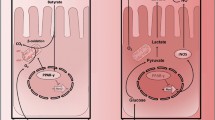Abstract
Aim
The aim of this study is to examine the expression level and localization of calprotectin in cancer tissue, tumor-adjacent mucosa, and polyps in colonic biopsies. Calprotection expression was correlated with neutrophil infiltration, markers of bacteremia, and systemic inflammation.
Materials and methods
Patients with colorectal cancer (n = 28) and adenoma (n = 38) were compared with healthy controls (n = 33). Calprotectin expression levels were measured by ELISA, and its localization was visualized by immunohistochemistry and correlated with the degree of neutrophil infiltration (visualized by Esterase staining). The expression of tumor necrosis factor (TNF)-alpha, procalcitonin, endotoxemia, carcinoembryonic antigen (CEA), and C-reactive protein was also investigated.
Results
Mucosal calprotectin was expressed in significantly higher concentrations in carcinoma (94.2 ± 31.2 ng/mg total protein) and adenoma (122.8 ± 60.3 ng/mg total protein) in comparison with mucosal biopsies from healthy controls (20.4 ± 5.4 ng/mg total protein), tumor-adjacent mucosa from patients with colorectal carcinoma (21.6 ± 5.1 ng/mg total protein), and adenoma (45 ± 14.6 ng/mg total protein, all p < 0.05). Immunohistochemistry showed calprotectin reactivity mainly in granulocytes and macrophages with only singular reactive epithelial cells. Positive staining (quantified by the number of positive cells per square millimeter) was markedly increased in carcinoma tissue (85 ± 21.5) and in adenoma (67.5 ± 20) as compared with tumor-adjacent epithelia (18.8 ± 4.3, p = 0.0007, p = 0.003, respectively), and there was a highly significant correlation, r = 0.89, p = 0.001) between calprotectin staining and neutrophil infiltration. No significant differences were found in the systemic levels of TNF-alpha, procalcitonin, and endotoxemia, whereas CEA and C-reactive protein levels were significantly higher in the cancer group (p < 0.05).
Conclusion
Our results support the evidence that increased calprotectin expression is an early step in the neoplastic transformation during colorectal carcinogenesis. Moreover, its expression is closely related to an inflammatory response and points out a possible biological link between inflammation and neoplastic transformation in colorectal cancer.


Similar content being viewed by others
References
Balkwill F, Mantovani A (2001) Inflammation and cancer: back to Virchow? Lancet 357(9255):539–45
Eaden JA, Abrams KR, Mayberry JF (2001) The risk of colorectal cancer in ulcerative colitis: a meta-analysis. Gut 48(4):526–35
Darfeuille-Michaud A, Boudeau J, Bulois P, Neut C, Glasser AL, Barnich N, Bringer MA, Swidsinski A, Beaugerie L, Colombel JF (2004) High prevalence of adherent-invasive Escherichia coli associated with ileal mucosa in Crohn’s disease. Gastroenterology 127(2):412–21
Swidsinski A, Khilkin M, Kerjaschki D, Schreiber S, Ortner M, Weber J, Lochs H (1998) Association between intraepithelial Escherichia coli and colorectal cancer. Gastroenterology 115(2):281–6
Kristinsson J, Roseth A, Fagerhol MK, Aadland E, Schjonsby H, Bormer OP, Raknerud N, Nygaard K (1998) Fecal calprotectin concentration in patients with colorectal carcinoma. Dis Colon Rectum 41(3):316–21
Poullis A, Foster R, Mendall MA, Fagerhol MK (2003) Emerging role of calprotectin in gastroenterology. J Gastroenterol Hepatol 18(7):756–62
Dale I, Brandtzaeg P, Fagerhol MK, Scott H (1985) Distribution of a new myelomonocytic antigen (L1) in human peripheral blood leukocytes. Immunofluorescence and immunoperoxidase staining features in comparison with lysozyme and lactoferrin. Am J Clin Pathol 84(1):24–34
Hessian PA, Edgeworth J, Hogg N (1993) MRP-8 and MRP-14, two abundant Ca(2+)-binding proteins of neutrophils and monocytes. J Leukoc Biol 53(2):197–204
Boussac M, Garin J (2000) Calcium-dependent secretion in human neutrophils: a proteomic approach. Electrophoresis 21(3):665–72
Rammes A, Roth J, Goebeler M, Klempt M, Hartmann M, Sorg C (1997) Myeloid-related protein (MRP) 8 and MRP14, calcium-binding proteins of the S100 family, are secreted by activated monocytes via a novel, tubulin-dependent pathway. J Biol Chem 272(14):9496–502
Yui S, Nakatani Y, Mikami M (2003) Calprotectin (S100A8/S100A9), an inflammatory protein complex from neutrophils with a broad apoptosis-inducing activity. Biol Pharm Bull 26(6):753–60
Costa F, Mumolo MG, Ceccarelli L, Bellini M, Romano MR, Sterpi C, Ricchiuti A, Marchi S, Bottai M (2005) Calprotectin is a stronger predictive marker of relapse in ulcerative colitis than in Crohn’s disease. Gut 54(3):364–8
Aggarwal BB, Shishodia S, Sandur SK, Pandey MK, Sethi G (2006) Inflammation and cancer: how hot is the link? Biochem Pharmacol 72(11):1605–21
Kronborg O, Ugstad M, Fuglerud P, Johne B, Hardcastle J, Scholefield JH, Vellacott K, Moshakis V, Reynolds JR (2000) Faecal calprotectin levels in a high risk population for colorectal neoplasia. Gut 46(6):795–800
von Roon AC, Karamountzos L, Purkayastha S, Reese GE, Darzi AW, Teare JP, Paraskeva P, Tekkis PP (2007) Diagnostic precision of fecal calprotectin for inflammatory bowel disease and colorectal malignancy. Am J Gastroenterol 102(4):803–13
Meucci G, D’Incà R, Maieron R, Orzes N, Vecchi M, Visentini D, Minoli G, PontE D, Zilli M, Benedetti E, Virgilio T, Tonutti E (2010) Diagnostic value of faecal calprotectin in unselected outpatients referred for colonoscopy: a multicenter prospective study. Dig Liver Dis 42(3):191–5
Tugizov S, Berline J, Herrera R, Penaranda ME, Nakagawa M, Palefsky J (2005) Inhibition of human papillomavirus type 16 E7 phosphorylation by the S100 MRP-8/14 protein complex. J Virol 79(2):1099–112
Hiratsuka S, Watanabe A, Aburatani H, Maru Y (2006) Tumour-mediated upregulation of chemoattractants and recruitment of myeloid cells predetermines lung metastasis. Nat Cell Biol 8(12):1369–75
Acknowledgements
We wish to thank Mr Volker Ott, MD, for his skilful assistance in manuscript writing.
Author information
Authors and Affiliations
Corresponding author
Rights and permissions
About this article
Cite this article
Luley, K., Noack, F., Lehnert, H. et al. Local calprotectin production in colorectal cancer and polyps—active neutrophil recruitment in carcinogenesis. Int J Colorectal Dis 26, 603–607 (2011). https://doi.org/10.1007/s00384-011-1165-0
Accepted:
Published:
Issue Date:
DOI: https://doi.org/10.1007/s00384-011-1165-0




